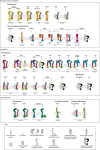Apoplastic invasion patterns triggering plant immunity: plasma membrane sensing at the frontline
- PMID: 31353775
- PMCID: PMC6804340
- DOI: 10.1111/mpp.12857
Apoplastic invasion patterns triggering plant immunity: plasma membrane sensing at the frontline
Abstract
Plants are able to effectively cope with invading pathogens by activating an immune response based on the detection of invasion patterns (IPs) originating from the pathogen or released by the plant after infection. At a first level, this perception takes place at the plasma membrane through cell surface immune receptors and although the involvement of proteinaceous pattern recognition receptors (PRRs) is well established, increasing data are also pointing out the role of membrane lipids in the sensing of IPs. In this review, we discuss the evolution of various conceptual models describing plant immunity and present an overview of well-characterized IPs from different natures and origins. We summarize the current knowledge on how they are perceived by plants at the plasma membrane, highlighting the increasingly apparent diversity of sentinel-related systems in plants.
Keywords: PRR; invasion patterns; lipids; pattern-triggered immunity; plasma membrane.
© 2019 The Authors. Molecular Plant Pathology published by British Society for Plant Pathology and John Wiley & Sons Ltd.
Figures

References
-
- Van den Ackerveken, G. (2017) How plants differ in toxin‐sensitivity. Science, 358, 1383–1384. - PubMed
-
- Adachi, H. , Derevnina, L. and Kamoun, S. (2019) NLR singletons, pairs, and networks: evolution, assembly, and regulation of the intracellular immunoreceptor circuitry of plants. Curr. Opin. Plant Biol. 50, 121–131. - PubMed
-
- Albert, I. , Böhm, H. , Albert, M. , Feiler, C.E. , Imkampe, J. , Wallmeroth, N. , Brancato, C. , Raaymakers, T.M. , Oome, S. , Zhang, H. , Krol, E. , Grefen, C. , Gust, A.A. , Chai, J. , Hedrich, R. , Van den Ackerveken, G. and Nürnberger, T. (2015) An RLP23‐SOBIR1‐BAK1 complex mediates NLP‐triggered immunity. Nat. Plants, 1, 15140. - PubMed
Publication types
MeSH terms
Substances
LinkOut - more resources
Full Text Sources

